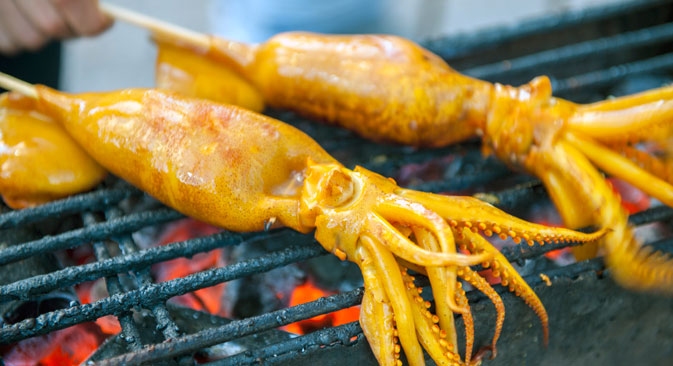
Grilled octopus for sale. Source: Getty Images
The South Korean government is working hard to globalize Korean culture. They even have a government-sponsored program, which is aimed at transforming Korean cuisine into one of the five most popular cuisines in the world. Currently, South Korean gastronomic bureaucrats think that the top five consist of Italian, French, Chinese, Japanese and Thai cuisine.
I tend to be somewhat skeptical, and strongly suspect that Korean cuisine is too spicy for the average Western palate. Of course, I don’t particularly enjoy hot and spicy food, so I may be biased.
That said, there is one country where Korean cuisine has been successful beyond the wildest dreams of Seoul’s culinary technocrats. This country is Russia, where Korean cuisine now occupies a position similar to that of Chinese cuisine in America, that is affordable and exotic. No supermarket in a major Russian town would be complete without a small Korean section, where what is known as Korean salads can be bought. It seems that no other Asian cuisine even comes close to such prominence in Russia, or for that matter the entire former Soviet Union.
In a sense, this is understandable. Unlike the United States, Russia has never had a sizable Chinese or Japanese minority (nearly all Chinese migrants are relatively new arrivals), while ethnic Koreans have lived in Russia since the 1860s.
However, the average Korean in Seoul or for that matter Pyongyang would not recognize the dishes that are sold in Russian supermarkets as Korean food. These Korean salads are completely alien to the inhabitants of the Korean peninsula. They are, in fact, not Korean food, but rather the cuisine of Russian Koreans, which is dramatically different to the Korean food so dear to the hearts of Seoul’s culinary apparatchiks.
The epitome of this phenomenon is a dish known in Russia as Korean Carrot. Pretty much every Russian thinks of this dish as being the most popular dish in Korea itself. Koreans themselves usually think of Kimchi in such a way, but this spicy, fermented cabbage is all but unknown in Russia. Korean Carrot is composed of fresh carrot sliced into thin slices and seasoned with a slightly sweet marinade made with garlic, coriander, pepper, vinegar, sugar and sunflower oil.
Most Russian visitors to Seoul are surprised and shocked to discover that no one has ever heard of Korean Carrot there (indeed, there is nothing that resembles it in Korean cooking). Just imagine an American, who upon arriving in Italy, cannot find a pizza or an Italian who has ever heard of one!
The origin of Russian-Korean cuisine is easy to trace. Korean cuisine is centered around rice, served with a variety of side dishes (known as panch’an in Korean). In 1937, most Koreans, previously located in Russia’s Primorye Territory were forcibly relocated to Central Asia. There they could not find many of the ingredients they cooked with (it is not so easy to find seaweed in the dessert) and began to look for substitutes. They also began to adjust to the palates of their Russian, Uzbek and Kazak neighbors. They reduced the amount of chili pepper they used and usually added liberal amounts of sugar and animal oil. The result was a runaway commercial success.
This might be a lesson for Seoul’s bureaucracy. Korean cuisine became popular in Russia because it was not authentic. Traditional Korean dishes were modified to suit local palates and local conditions. Whether the resultant dishes remain part of Korean cuisine or not is open to debate, but millions of customers in the former Soviet Union enjoy it nonetheless.
This article was first published by RBTH Asia.
All rights reserved by Rossiyskaya Gazeta.
Subscribe
to our newsletter!
Get the week's best stories straight to your inbox